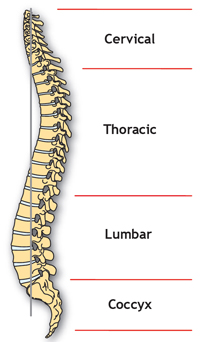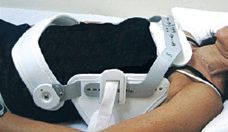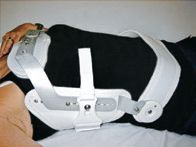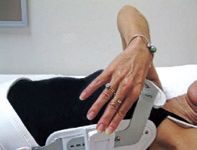Jewett brace
What is a Jewett brace?
The Jewett brace is designed to give support to your thoracic and lumbar spine by preventing twisting and flexion (bending forward). It will also keep your back in the correct position while you are healing from your injury and/or surgery.

The spinal column
The spinal column is made up of many parts. These include bones, joints, ligaments, tendons, the spinal cord and nerves.
The function of the spinal column is to:
- provide structural support and balance to stay in an upright posture
- protect the spinal cord, nerve roots and some internal body organs
- allow flexible movement.
An injury to the spine can result in fractures (broken bones), dislocations (bones move away from a normal position), subluxations (incomplete dislocations), joint, ligament and tendon damage. Ligaments and tendons connect two or more bones together and help keep the joint and the spine stable on movement and rest.
These types of injuries can take up to 3 months to heal, and surgery may be required to treat some of them.
Diagnosis of injuries
Injuries are diagnosed either using X-rays and/or MRI and CT scans. For healing and prevention of further injury it is important that the spine remains in the correct position and the injury is stabilised.
Who will fit your brace?
An orthotist or experienced nurse will fit your Jewett brace. Once you start to move around, adjustments may be needed.
Only allow qualified people to adjust your brace. Please call your orthotist or a qualified nurse to make any further adjustments.
How to apply your brace
You should put your brace on while you are in bed and lying down.
Step 1

While lying on your back fit the brace across the chest/abdomen area. The lock on the left side is to remain unlocked at this stage.
The left hand side of the brace is unlocked.
Step 2

Roll onto your side using the log roll method taught to you while in hospital. Ensure that the spine support pad is placed over the area where your injury is located.
The spine pad is placed where your injury is located.
Step 3

Roll onto your back.
Place the keyhole clip over the metal screw.
The key hole clip is placed over the metal screw.
Step 4

On the left side close the lock to tighten the brace.
Be careful not to pinch your skin when closing the lock.
Make sure your brace fits firmly.
When to wear your Jewett brace
You will need to wear your brace:
• in the shower
• while sitting
• while walking
• in the car.
Most people wear the brace between 6 to 12 weeks. Your spinal doctor will tell you how long to wear your brace. An X-ray may be necessary before you can stop wearing it.
When to take your brace off
Unless told otherwise by your doctor, when you lie down flat you can take off your brace as well as at night when you are sleeping.
Care of your brace
- You will need someone else to wash your brace.
- Clean by sponging with soap and water to remove sweat and dirt.
- Wash with warm soapy water if it becomes soiled and hang out to dry.
- Reapply your brace when it is dry.
Activities to avoid while wearing your brace
The following activities should be avoided while wearing your brace:
- flexion, twisting or turning of your body
- driving a motor vehicle
- physical sports or running
- heavy lifting or manual work.
Check with your spinal doctor when you are able to resume these activities.
Be careful around small pets and children. Keep your environment free of obstacles such as mats, cords and rugs that you may trip over.
Helpful Suggestions
- You may be more comfortable wearing a cotton singlet or t-shirt under your brace (preferably without a seam).
- Wear loose easy fitting clothes over your brace.
- Wear comfortable practical shoes (no thongs, high heels or shoes that have a slippery sole).
- Check your skin for any redness or blistered areas and protect these areas. Use a mirror to avoid any dangerous movements.
- Report any skin problems or any other problems to your orthotist, nurse or spinal doctor.
- Shower in your brace at night just before you go to bed, remove the brace and this will allow time for the brace and straps to dry overnight.
- You may use plastic wrap around your brace to keep it dry when showering.
Where to get help
- See your doctor.
- Visit a GP after hours.
- Ring healthdirect Australia on 1800 022 222.
- Your orthotist.
Remember
- The Jewett brace gives support to your thoracic/lumbar spine by preventing twisting and flexion
- Injuries can take up to 3 months to heal.
- Surgery may be required to treat some injuries.
Acknowledgements
Royal Perth Hospital
This publication is provided for education and information purposes only. It is not a substitute for professional medical care. Information about a therapy, service, product or treatment does not imply endorsement and is not intended to replace advice from your healthcare professional. Readers should note that over time currency and completeness of the information may change. All users should seek advice from a qualified healthcare professional for a diagnosis and answers to their medical questions.